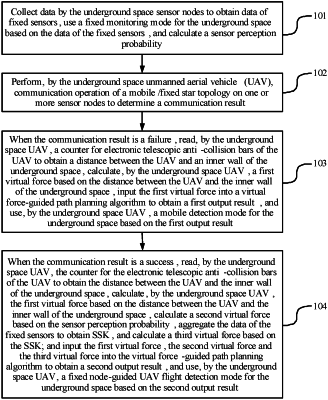| CPC G08G 5/80 (2025.01) [B64U 20/30 (2023.01); G01C 21/20 (2013.01); G08G 5/55 (2025.01); G08G 5/57 (2025.01); B64U 2101/70 (2023.01)] | 9 Claims |

|
1. A detection method for an underground space by joint use of fixed sensors and unmanned aerial vehicle (UAV) movement detection, which is implemented by a detection system for an underground space by joint use of fixed sensors and UAV movement detection that comprises underground space sensor nodes and an underground space UAV,
wherein the detection method comprises:
collecting data by the underground space sensor nodes to obtain data of fixed sensors, using a fixed monitoring mode for the underground space based on the data of the fixed sensors, and calculating a sensor perception probability;
performing, by the underground space UAV, communication operation of a mobile/fixed star topology on one or more sensor nodes to determine a communication result; and
when the communication result is a failure, reading, by the underground space UAV, a counter for electronic telescopic anti-collision bars of the UAV to obtain a distance between the UAV and an inner wall of the underground space, calculating, by the underground space UAV, a first virtual force based on the distance between the UAV and the inner wall of the underground space, inputting the first virtual force into a virtual force-guided path planning algorithm to obtain a first output result, and using, by the underground space UAV, a movement detection mode for the underground space based on the first output result; when the communication result is a success, reading, by the underground space UAV, the counter for the electronic telescopic anti-collision bars of the UAV to obtain the distance between the UAV and the inner wall of the underground space, calculating, by the underground space UAV, the first virtual force based on the distance between the UAV and the inner wall of the underground space, calculating a second virtual force based on the sensor perception probability, aggregating the data of the fixed sensors to obtain structural spatiotemporal evolution knowledge (SSK), and calculating a third virtual force based on the SSK; and inputting the first virtual force, the second virtual force and the third virtual force into the virtual force-guided path planning algorithm to obtain a second output result, and using, by the underground space UAV, a fixed node-guided UAV flight detection mode for the underground space based on the second output result;
wherein the first virtual force is a repulsive force Fw-v of the inner wall of the underground space to the underground space UAV, and a formula for calculating the first virtual force is shown in formula (2) as follows:
 wherein δ is a coefficient of a virtual repulsive force Fw-v, d(v, w) means the distance between the UAV and the inner wall of the underground space, and d(v, w) is read based on the electronic telescopic anti-collision bars.
|